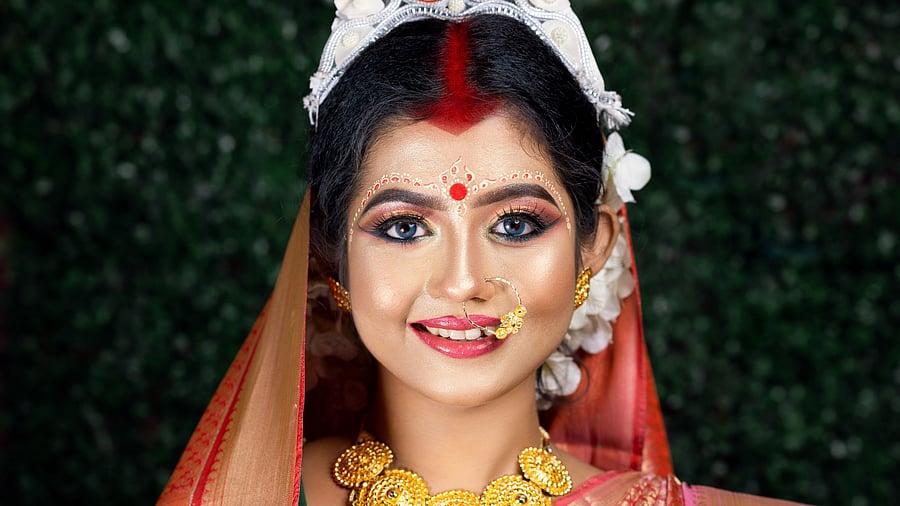
Representative image showing a Bengali bride.
Credit: iStock Photo
Most of us are aware of the song, O Sajna, barkha bahaar aayi, from the movie Parakh, in which Sadhana sings eloquently of the onset of the lush-ripe spring that brings about a spurting of nature’s juices and human emotions (including love). While everyone is full of admiration for the song’s melody, Lata Mangeshkar’s flawless voice, and Sadhana’s beauty, all of my attention remains polarised in one place: Sadhana’s bewitching bindi.
My first tryst with the bindi was when I was three, and I was to dress as a Bengali bride for a school programme. Given the limited resources we used to have back in the 80s, my teachers managed to procure a gorgeous red sticker bindi from somewhere and used a mixture of talcum powder with water to create a version of the kolka chandan bindi typically worn by Bengali brides. I had been tonsured at Tirupati just the week before and was bald as an egg, yet I was so enthralled by the sight of my artistic bindi that my lack of crowning glory didn’t bother me at all.
As I grew, so did my bindi collection. While my friends dazzled with glittering gems and liquid rainbow hues, my fascination lay in unconventional shapes: pine trees reaching for the sky, serpents coiling with majestic hoods, anchors tethering ships in tempests, and graceful swans gliding on invisible currents. Each bindi was a tiny masterpiece, tethering me to my individuality in a world that demanded conformity.
In 1993, Steven Spielberg released his movie Jurassic Park, which, with its story of dinosaurs and their cloning, captured the imagination of every child on earth. During this period, I had a classmate whose father frequently travelled to metros. One day, the classmate came to school with an excitement she was barely able to conceal. She opened her knapsack, and what spilled out was a strip of bindis in the form of Tyrannosaurus, Spinosaurus, Velociraptor, and every other kind of dinosaur that had been depicted in Jurassic Park! Egged on by our encouragement, the girl was emboldened enough to start wearing her dinosaur bindis to school with our uniform until she was caught during the school assembly and reminded that she was a student, not a fashion icon. We didn’t see our friend in her dinosaur bindis ever again.
The early 2000s saw the emergence of saas-bahu serials, in which gigantic vertical bindis became the hallmark of the vamp. So, while the heroine wore simple makeup, ordinary salwar suits, and a tiny little dot for a bindi, the vamps swished about in sequinned sarees, sleeveless blouses, ultra glamorous makeup, and yes, the most impressive bindi ever! However, this time around, I could only admire, but not ape, their style. With rising study pressure bringing with it a dearth of time, I no longer had the inclination nor the enthusiasm to indulge my
bindi fetish.